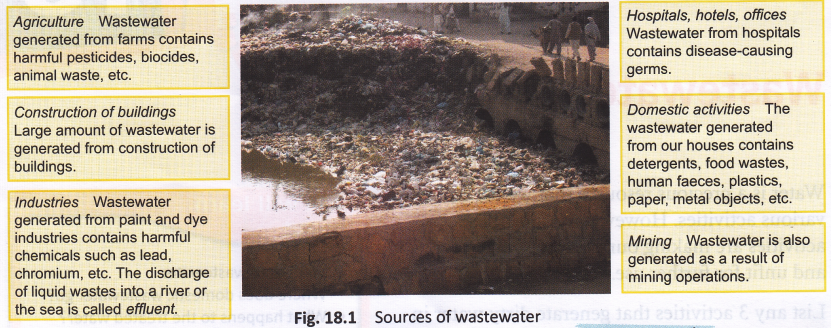Sources Of Wastewater
Water that has been used and has become dirty is called wastewater. It is generated as a result of numerous human activities.
- Agriculture: Wastewater generated from farms contains harmful pesticides, biocides, animal waste, etc.
- Construction of buildings: Large amount of wastewater is generated from construction of buildings.
- Industries: Wastewater generated from paint and dye industries contains harmful chemicals such as lead, chromium, etc. The discharge of liquid wastes into a river or the sea is called effluent.
- Hospitals, hotels, offices: Wastewater from hospitals contains disease-causing germs.
- Domestic activities: The wastewater generated from our houses contains detergents, food wastes, human faeces, plastics, paper, metal objects, etc.
- Mining: Wastewater is also generated as a result of mining operations.

All the wastewater that is released from various sources contains suspended impurities. This wastewater, containing suspended impurities, is called sewage. These impurities are called contaminants.
Where Does Domestic Wastewater Go?
Each time we wash something or flush our toilets, water containing paper, cloth, soap, detergent, oil, grease, food scrap, faeces, etc., goes down the drain. This water accumulates and forms sewage. In large cities, this is known as municipal wastewater.
The Sewer System
A channel system of pipelines used to carry sewage is called the sewer system. The sewage leaves houses through drain pipes and flows to the sewer mains of the city. The sewer mains flow into progressively larger pipes until they reach the wastewater treatment plant.
Waste flows easily through sewers due to a slight slope given to the drainage system. Most sewer pipes are underground. So, what does one do if there is a leak or blockage in any of these pipes? For this purpose, there are manholes (a hole, usually with a cover) through which a person may enter a sewer or drain to fix the faulty pipes.